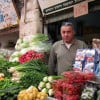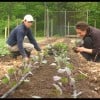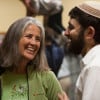by Emily Glick, Teva, Hazon, Falls Village, CT Parashat Shoftim Editor’s Note: Welcome to D’varim HaMakom: The JOFEE Fellows Blog! Most weeks throughout the year, you’ll be hearing from the JOFEE Fellows: reflections on their experiences, successful programs they’ve planned and implemented, gleanings from the field, and connections to the weekly Torah portion and what they’ve learned from their experiences with place in their host communities for the year. Be sure to check back weekly! P.S. Interested in being or hosting a JOFEE Fellow? Applications for cohort two are now open for both prospective fellows and prospective host institutions! My debut expedition as Teva’s first JOFEE Fellow began in a transformational grease machine / holy mobile space most commonly known to the greater world as the Topsy Turvy Bus. Having just completed a three-week JOFEE Fellowship orientation and training intensive seminar, I was leading our seven-week Mayim l’Mayim themed bus tour fueled on used cooking oil, holy vibes, and Torah – not to mention the passion of our 5 radiantly unique bus educators, all of whom brought skills and essential senses of humor that our tour would not have succeeded without. Our team performed in camp talent shows; saw shooting stars; wrote […]
Topic: Jewish Texts
Shmita, like Shechina, Goes Global: Reflections from a Hammock on This Shmita Year
By Amichai Lau-Lavie A year ago I was laying in a hammock on a Brazilian beach, planning a year’s worth of Shmita study and action that will rebrand this ancient sustainability practice rooted in the Land of Israel for new digital generations all over the world. Hovering between earth and sky provided the perfect setting to what I was designing: An adaptation of the Shmita concept beyond its original halachic, geographical and agricultural settings so that it will prove useful and meaningful to so many more of us. Now that the year is almost up and FallowLab, the project I designed, is starting its descent, it’s time to get back into the hammock and reflect on lessons learned and theories tested. Many creative projects and conversations emerged this year with varying degrees of success at wrestling with Shmita and offering ambitious renditions and new traditions. What sticks for future? Did we live up to the values of Shmita, did this year live up to expectations? Luckily I don’t have to go back to Brazil to find a reflection-friendly hammock. When I got back home last summer I set up a shmita garden in my Manhattan backyard: Stripped the garden of […]

Because Sometimes it Rains on Your Sukkah
by Sarah Chandler Geshem Be’ito (Acceptance of Rain in Its Time) The following essay will be published in the forthcoming book of teachings “Good Noticing” published by the Institute for Jewish Spirituality. The rhythms of the Jewish calendar may not coincide with your particular climate. At times, our traditional rituals may range from the impractical to the impossible. For example, in the Northern Hemisphere, calling upon light in the darkness of Chanukah in Kislev/December always resonates, but singing about blossoming trees in Shevat/January may not make sense. How can we stay true to our tradition when the weather doesn’t cooperate? And as mindfulness practitioners, how might we elevate the news of undesirable weather? Those of us who live in the Northeastern United States are usually blessed with bountiful precipitation year-round. Furthermore, our religion is no longer based on the careful balance between following God’s laws and receiving in return enough rain for our crops to survive. The Reform movement even removed the second paragraph of the Shema from prayer books to make the bold statement: we are modern Jews—we do not believe that we can influence God to change the weather by keeping the commandments of our tradition. Recent evidence […]

Eco-Judaism: The Torah Mandala and the Mystical System of Sustainability
By Rabbi Elisheva Brenner In the Torah “holiness” is part of an idiosyncratic way of understanding how the cosmos came into being, our place in it (cosmogony) and the nature of reality (epistemology). To our ancient ancestors, the cosmos, the physical world as we experience it, all life was brought about by “the word of G-d.” Today we would regard “the word of God” as a metaphor for the energies, forces, karma, particle and wave plus the energy of human consciousness that concentrates, compresses, expands and contracts into what we experience as the physical and spiritual world. When the energies of life are in properly balanced, albeit dynamic, homeostasis, the life system has achieved a state of sustainability. In Torah-speak, that homeostasis, that sustainability, is called “Holiness.” The parts of the system as well as the objects, actions and time intervals used to maintain and correct the system are called “Holy.” We can find our way into the Torah’s way of understanding through the study of language and literary structural forms. Language is a window onto the way a people or culture perceives reality. It both arises from and reifies a culture’s epistemology. Biblical Hebrew is a language that […]

With All Your Heart, With All Your Soul, With All Your Might
“With all your heart, with all your soul, with all your might”. This is my mantra. Not because I am a person who davens three times a day reciting this phrase from its original source in the Sh’ma, but simply because I think it’s beautiful. Imagine a world in which we dedicated our whole selves to every mitzvah we preform, every fleeting thought we have. In a gemara in the tractate of Brachot, the Rabbis expound upon each of these segments: “With all your heart” they explain as what Freud might call the “id”—that is the most instinctual, animalistic parts of ourselves, “with all your soul” refers to our actual life, and “with all your might” commonly refers to our physical possessions. I strive preform every action with all my heart, soul, and might whether it’s loving God as the original texts indicates, loving a friend or a stranger as some scholars interpret, doing a project at work, or even something as mundane as grocery shopping (I said strive!). (more…)
Shmita: Weaving Relational Threads
by Yigal Deutscher The tribes of Israel have just gathered together, am echad b’lev echad, one nation with one synchronized heart, in alignment and in unity. They have just stood, in deep humility, in awe, in trepidation, witnessing and receiving a divine gift. They have emerged from the brokenness of slavery; they have traveled through the wilderness for 50 days, only to stand together in this moment, before a mountain covered in fire, topped with thundering clouds, shimmering with lightning, rippling with the sounds of the Shofar. 1o utterances have emerged from the heart of creation; 10 utterances so clear and powerful that the tribes could actually see & feel each of them, as they echoed from the mountain, from the sky, from the ground and rock and sand below their feet, and from within their own beating hearts. (more…)

The Sabbatical Debt Release
By Yigal Deutscher In the third and final mention of Shmita in the Torah, the concept of Shmita expands to directly influence economic and monetary systems. Until now (sources in Shemot & Vayikra), Shmita texts have been specifically in reference to land, agricultural practices, and annual harvests. Here, with the text of Devarim, the picture and implications of the Shmita Year is complete: Along with the practices of leaving land fallow, opening private lands as commons, collectively sharing the harvest, we are also to synonymously forgive debts. Once the Seventh Year arrives, all loans which are outstanding are released and all debts are cancelled. Here are some thoughts to consider regarding this practice (see the full text here): (more…)
Review of “God’s Prayer: The Sacred Task of Living,”
by Yedidya Sinclair “Why doesn’t God speak to people any more?” my five year old asked me the other day, after a few months of learning the stories of Genesis in her kindergarten. After all, God seemed to have so much to say to our ancestors. Why has He fallen so quiet lately? A philosopher friend at our Shabbat table who heard the question answered her, “Maybe God does still talk to people, but not in the way that He used to.” Perhaps an even more interesting question is, “what would God say today if He were to talk to people?” Would God criticize school children for the insufficient length of their blouse sleeves? Or weigh into the debate on whether public transport should run on Shabbat in Israel? Or perhaps offer an omniscient opinion regarding which presidential candidate was really best aligned with the interests of Israel and the Jewish people? Would God, in other words, talk about the sorts of things that we talk about? Michael Kagan, in his important and powerfully-written new book, ‘God’s Prayer’, thinks not. ‘God’s Prayer’ begins with a cry of anguish at the suffering and destruction that human beings are wreaking on Creation. […]
Genesis and Human Stewardship of the Earth
Jewcology is a diverse platform for Jewish environmental activists to learn from each other in order to educate Jewish communities about our responsibility to protect the environment. Hazon is excited to share these resources with you! We provide and promote ways to relate Jewish learning and Jewish teaching to environmental action and sustainability efforts. By Rabbi Yonatan Neril[1] The first two chapters of Genesis contain teachings with profound relevance for ourselves and our world today. After creating Adam and Eve, G-d blesses them, saying “Be fruitful and multiply, fill the earth and subdue it, and have dominion over the fish of the sea, and over the birds of the sky, and over every living thing that moves upon the earth.”[2] What does it mean for humans to subdue the earth and have dominion over other creatures? One of the central precepts of Rabbinic Judaism is that the Written Torah must be understood within the context of the 2,300 year-old rabbinic tradition (including the Midrash and other works) that interprets it. While on the surface the words of this verse appear to give people license to degrade and subdue the earth, the Oral tradition makes clear that a wholly different message […]

Holy Use: Relating to Resources Sustainably
When something breaks, the question may arise, repair it, or get rid of it and buy a new one?

New program – Jews and Earth: A Growing Community
Why was Adam’s “consequence” to work the soil? Why were many of the Bible heroes shepherds?

Rejuvenating Ourselves and Our Planet
Jewcology is a diverse platform for Jewish environmental activists to learn from each other in order to educate Jewish communities about our responsibility to protect the environment. Hazon is excited to share these resources with you! We promote the interrelatedness of shabbat as a time to reflect on environmental and sustainable ideas through many of our programs and resources. Our Food Guide has kosher sustainable meat options, Greening Your Shabbat Table, Sustainable Kiddush, and all of our Food Programs help you to draw connections between Jewish tradition and contemporary food issues. By Rabbi Yonatan Neril In modern society, we are running, speaking, and thinking at an exceptional rate, and oftentimes we continue all week long without slowing down. Constantly doing, always mobile accessible, habitually multi-tasking. If being too busy is a malady of modern man, slowing down on Shabbat may be a key remedy. The Torah teaches, “These are the things that the Divine commanded to make. Six days work may be done, but on the seventh day you shall have sanctity, a day of complete rest to G-d…” Achieving sanctity and complete rest is the stated goal of Shabbat. Yet how can this happen? (more…)

Sustainability in the Land of Israel
Jewcology is a diverse platform for Jewish environmental activists to learn from each other in order to educate Jewish communities about our responsibility to protect the environment. Hazon is excited to share these resources with you! We work to create a healthier and more sustainable Israel through our Israel Ride, our Sustainable Food Tour, and Siach (conversation). Learn more about sustainability in the land of Israel using this resource from Jewcology: By Rabbi Yonatan Neril Abraham and Sarah came to Israel over 3700 years ago. Since then, significant populations of Jews have spent over 1600 years living in the Land of Israel. For much of this time, Jews have been involved in growing crops, tending fruit trees, and shepherding animals, activities critical to providing food to sustain those living in Israel. Yet they also presented challenges to environmental sustainability in the Land. How did Jews manage to live in the Land for so long? While the Torah teaches that Divine Providence (in response to the people following the commandments) played the fundamental role, the Oral Tradition as redacted in the Mishna also provides insights. (more…)
The Unity and Purposefulness of Creation
By Rabbi Gavriel Weinberg Tu b’Shevat is an appropriate time to appreciate the greatness of Creation, and to honor it. We read in the third chapter of Pirke Avot (Chapters of the Fathers) a mishna that symbolizes the essence of the Torah’s regard for the purposefulness of all God’s creation. Ben Azai would be accustomed to say: He used to say, Despise not any man, and carp not at any thing; for thou wilt find that there is not a man that has not his hour, and not a thing that has not its place. (Translation by Charles Taylor) The mishna can be divided naturally into two subjects: Regard for essential purposefulness of any human being and that of anything that is not a human being. The second category, that of non human, has an interesting and peculiar use of the Hebrew language: AL TEHI MAFLEEG LKAL DAVAR. The above classic translation translates the verb MAFLIG as carp (to find fault with). Others translate MAFLEEG as dismissing of any thing. There are many other numerous attempts to translate such a unique word. Even though the numerous translations for the word MAFLEEG give a sensible meaning to the mishna, without a […]
A Jewish Perspective on the “Tragedy of the Commons”
By Rabbi Akiva Wolff Tu b’Shevat is an appropriate time to reflect on our relationship to the natural world, and our responsibility to it. In 1968, in one of the seminal articles written on the subject of environment protection, Garrett Hardin assured himself a place in the annals of the environmental movement. His article, titled The Tragedy of the Commons, became a ‘must-read’ for every budding environmentalist in the nation if not the world. The Tragedy of the Commons describes the ruination of a common pastureland, called the commons, by the herdsmen who share it. Each herdsman knows that for every additional animal he adds to his herd, he will recoup all the benefits, whereas the costs – in terms of pasturage for the animal and any damage to the commons caused by additional overgrazing – will be shared by everyone. Therefore, each herdsman tries to maximize the size of his herd, at the expense of everyone else. In Hardin’s words: “Therein is the tragedy. Each man is locked into a system that compels him to increase his herd without limit – in a world that is limited. Ruin is the destination toward which all men rush, each pursuing his […]



